Nursing Health Assessment: Clinical Reasoning Cycle for Older Adults
VerifiedAdded on 2023/01/10
|8
|1670
|67
Report
AI Summary
This report details a nursing health assessment conducted on older adults, utilizing the clinical reasoning cycle as a framework. The assessment begins by considering the patient's situation, emphasizing ethical considerations and building rapport. Data collection involves gathering information on past medical history, social and economic background, and family history through one-on-one interviews. The report addresses common health issues like arthritis, dementia, and diabetes prevalent in the elderly population, as well as lifestyle factors such as alcohol and smoking. The collected information is then processed through interpretation, discrimination, and relating of information to identify problems and risks, leading to the development of a care plan. The conclusion emphasizes the importance of a thorough health assessment in geriatric care, considering patient-specific factors and ethical considerations.
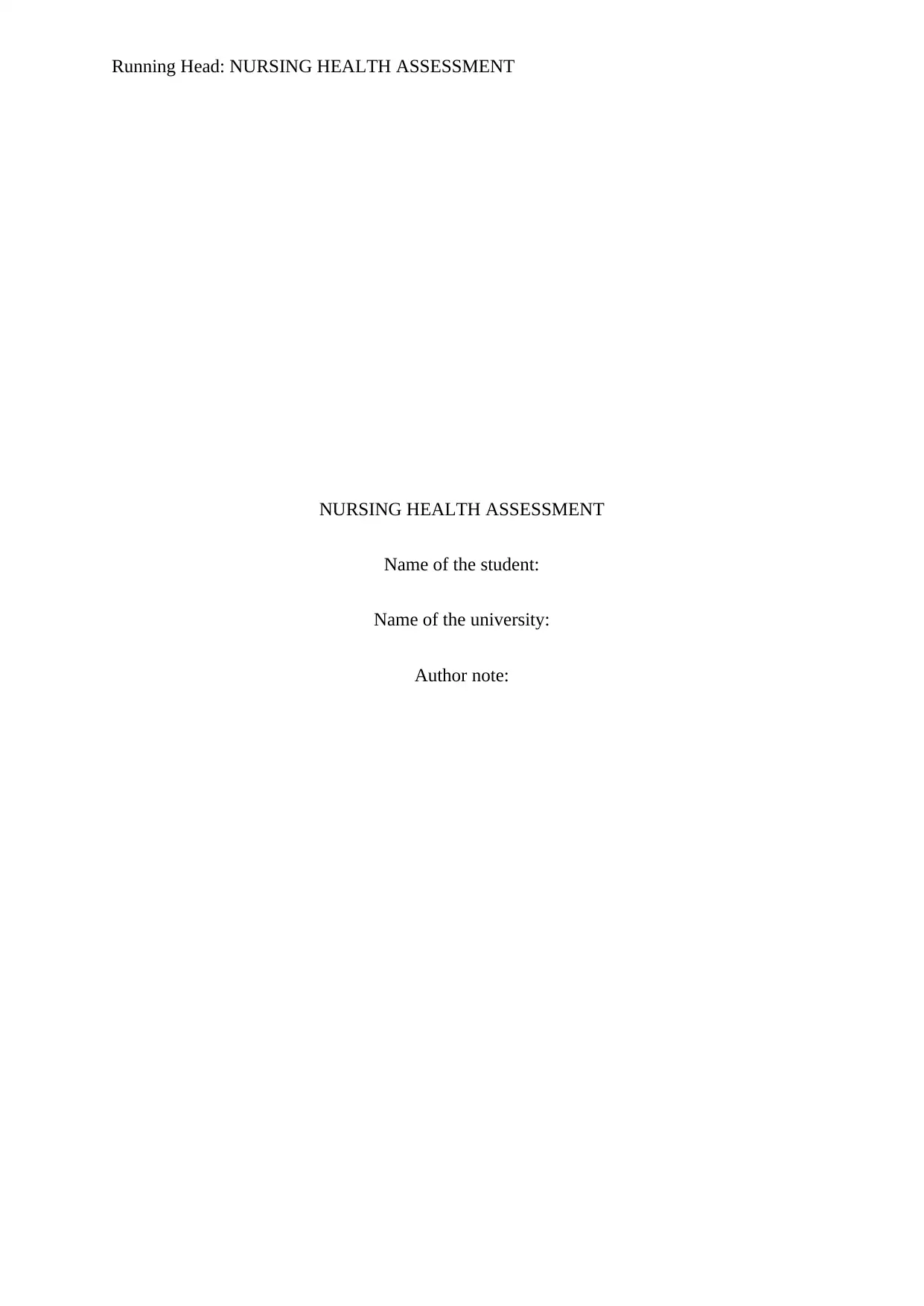
Running Head: NURSING HEALTH ASSESSMENT
NURSING HEALTH ASSESSMENT
Name of the student:
Name of the university:
Author note:
NURSING HEALTH ASSESSMENT
Name of the student:
Name of the university:
Author note:
Paraphrase This Document
Need a fresh take? Get an instant paraphrase of this document with our AI Paraphraser
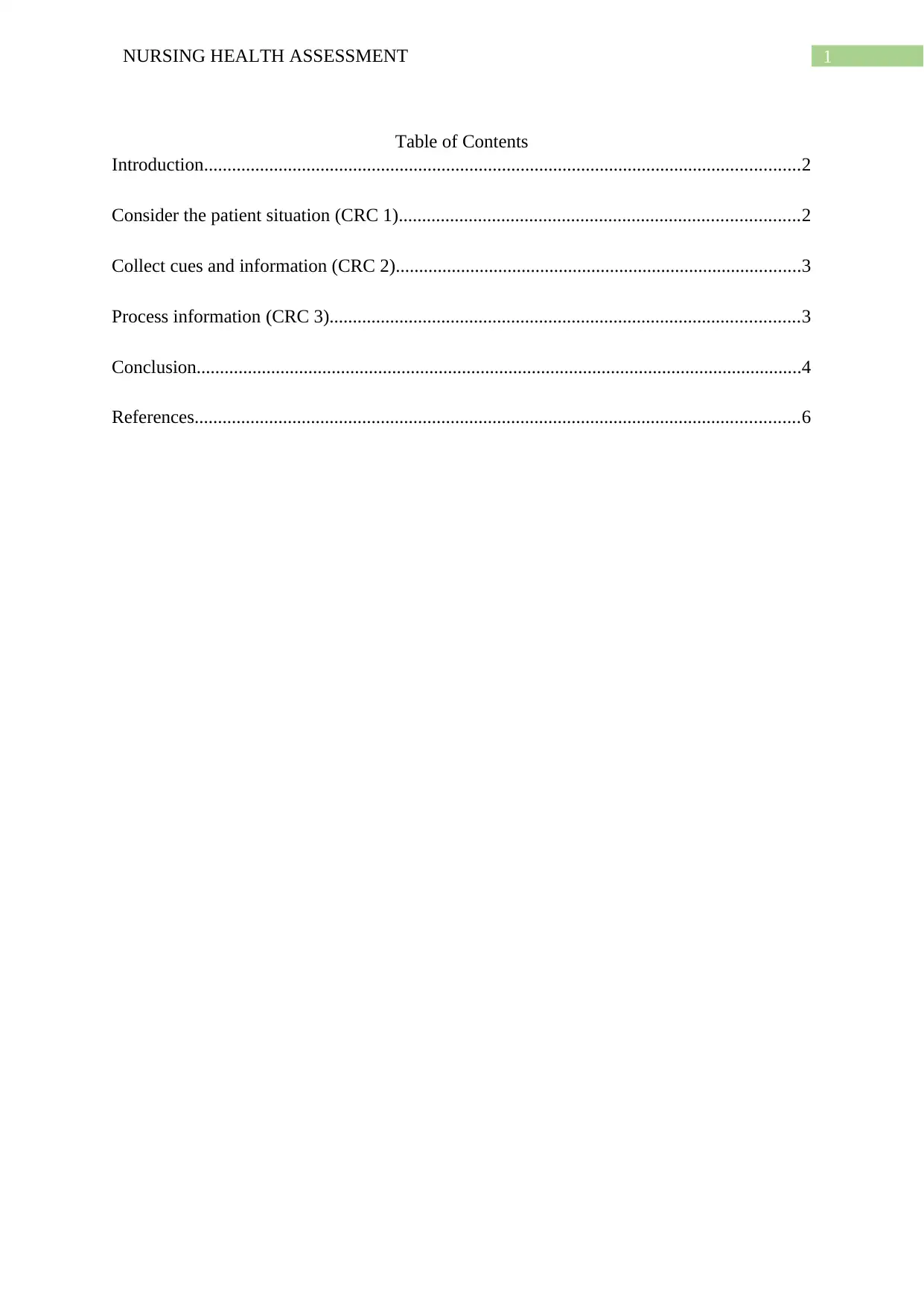
1NURSING HEALTH ASSESSMENT
Table of Contents
Introduction................................................................................................................................2
Consider the patient situation (CRC 1)......................................................................................2
Collect cues and information (CRC 2).......................................................................................3
Process information (CRC 3).....................................................................................................3
Conclusion..................................................................................................................................4
References..................................................................................................................................6
Table of Contents
Introduction................................................................................................................................2
Consider the patient situation (CRC 1)......................................................................................2
Collect cues and information (CRC 2).......................................................................................3
Process information (CRC 3).....................................................................................................3
Conclusion..................................................................................................................................4
References..................................................................................................................................6
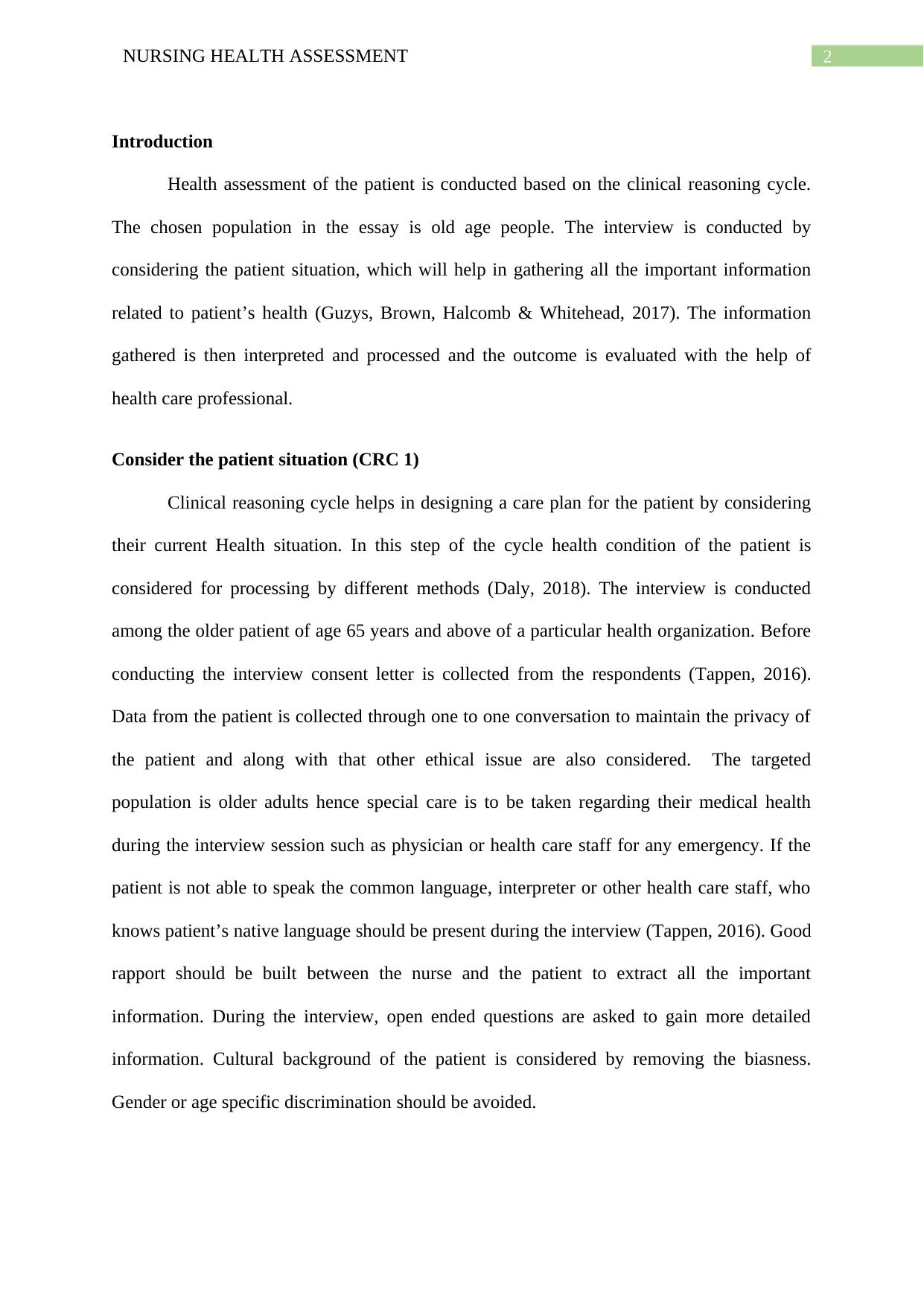
2NURSING HEALTH ASSESSMENT
Introduction
Health assessment of the patient is conducted based on the clinical reasoning cycle.
The chosen population in the essay is old age people. The interview is conducted by
considering the patient situation, which will help in gathering all the important information
related to patient’s health (Guzys, Brown, Halcomb & Whitehead, 2017). The information
gathered is then interpreted and processed and the outcome is evaluated with the help of
health care professional.
Consider the patient situation (CRC 1)
Clinical reasoning cycle helps in designing a care plan for the patient by considering
their current Health situation. In this step of the cycle health condition of the patient is
considered for processing by different methods (Daly, 2018). The interview is conducted
among the older patient of age 65 years and above of a particular health organization. Before
conducting the interview consent letter is collected from the respondents (Tappen, 2016).
Data from the patient is collected through one to one conversation to maintain the privacy of
the patient and along with that other ethical issue are also considered. The targeted
population is older adults hence special care is to be taken regarding their medical health
during the interview session such as physician or health care staff for any emergency. If the
patient is not able to speak the common language, interpreter or other health care staff, who
knows patient’s native language should be present during the interview (Tappen, 2016). Good
rapport should be built between the nurse and the patient to extract all the important
information. During the interview, open ended questions are asked to gain more detailed
information. Cultural background of the patient is considered by removing the biasness.
Gender or age specific discrimination should be avoided.
Introduction
Health assessment of the patient is conducted based on the clinical reasoning cycle.
The chosen population in the essay is old age people. The interview is conducted by
considering the patient situation, which will help in gathering all the important information
related to patient’s health (Guzys, Brown, Halcomb & Whitehead, 2017). The information
gathered is then interpreted and processed and the outcome is evaluated with the help of
health care professional.
Consider the patient situation (CRC 1)
Clinical reasoning cycle helps in designing a care plan for the patient by considering
their current Health situation. In this step of the cycle health condition of the patient is
considered for processing by different methods (Daly, 2018). The interview is conducted
among the older patient of age 65 years and above of a particular health organization. Before
conducting the interview consent letter is collected from the respondents (Tappen, 2016).
Data from the patient is collected through one to one conversation to maintain the privacy of
the patient and along with that other ethical issue are also considered. The targeted
population is older adults hence special care is to be taken regarding their medical health
during the interview session such as physician or health care staff for any emergency. If the
patient is not able to speak the common language, interpreter or other health care staff, who
knows patient’s native language should be present during the interview (Tappen, 2016). Good
rapport should be built between the nurse and the patient to extract all the important
information. During the interview, open ended questions are asked to gain more detailed
information. Cultural background of the patient is considered by removing the biasness.
Gender or age specific discrimination should be avoided.
⊘ This is a preview!⊘
Do you want full access?
Subscribe today to unlock all pages.

Trusted by 1+ million students worldwide
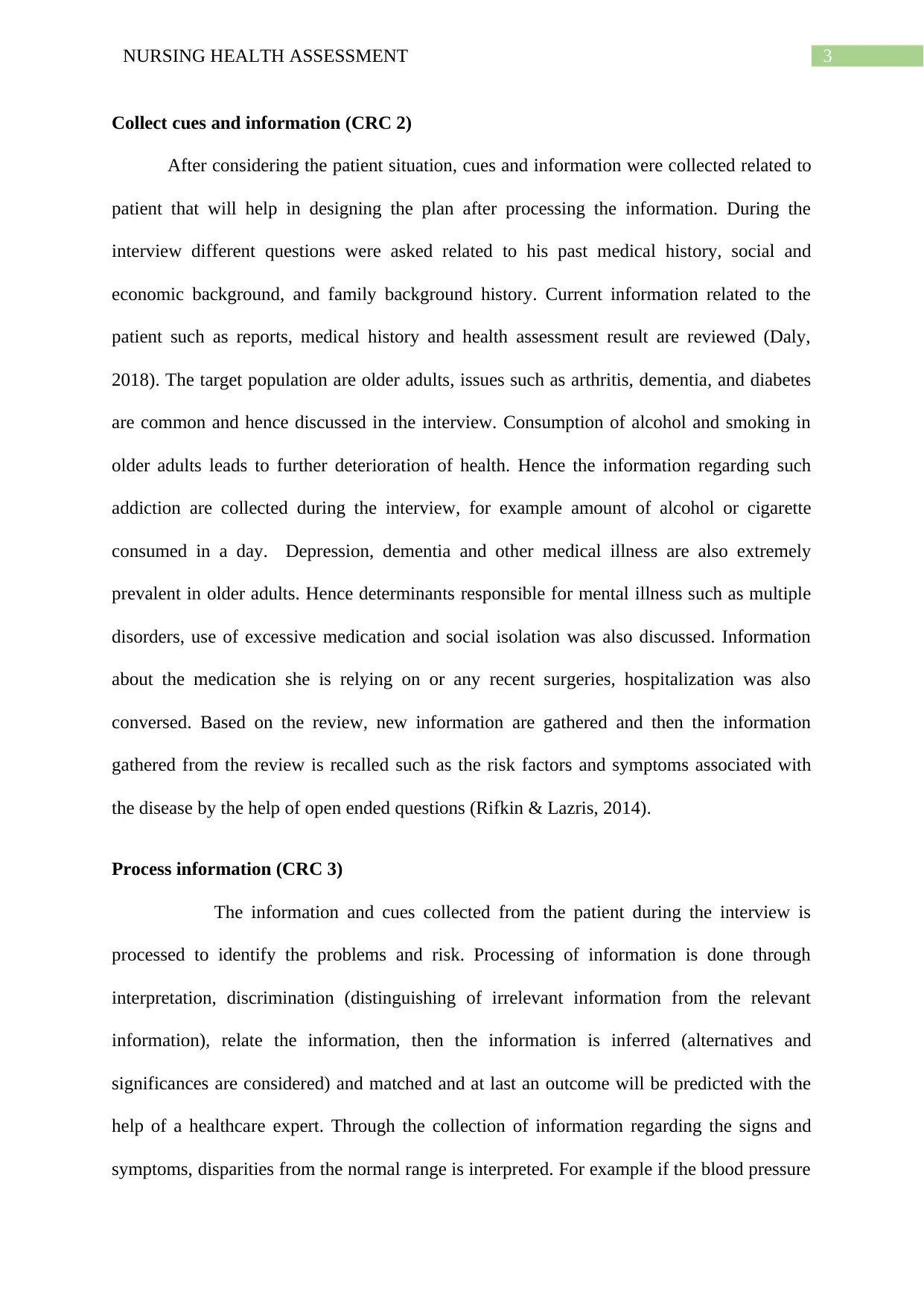
3NURSING HEALTH ASSESSMENT
Collect cues and information (CRC 2)
After considering the patient situation, cues and information were collected related to
patient that will help in designing the plan after processing the information. During the
interview different questions were asked related to his past medical history, social and
economic background, and family background history. Current information related to the
patient such as reports, medical history and health assessment result are reviewed (Daly,
2018). The target population are older adults, issues such as arthritis, dementia, and diabetes
are common and hence discussed in the interview. Consumption of alcohol and smoking in
older adults leads to further deterioration of health. Hence the information regarding such
addiction are collected during the interview, for example amount of alcohol or cigarette
consumed in a day. Depression, dementia and other medical illness are also extremely
prevalent in older adults. Hence determinants responsible for mental illness such as multiple
disorders, use of excessive medication and social isolation was also discussed. Information
about the medication she is relying on or any recent surgeries, hospitalization was also
conversed. Based on the review, new information are gathered and then the information
gathered from the review is recalled such as the risk factors and symptoms associated with
the disease by the help of open ended questions (Rifkin & Lazris, 2014).
Process information (CRC 3)
The information and cues collected from the patient during the interview is
processed to identify the problems and risk. Processing of information is done through
interpretation, discrimination (distinguishing of irrelevant information from the relevant
information), relate the information, then the information is inferred (alternatives and
significances are considered) and matched and at last an outcome will be predicted with the
help of a healthcare expert. Through the collection of information regarding the signs and
symptoms, disparities from the normal range is interpreted. For example if the blood pressure
Collect cues and information (CRC 2)
After considering the patient situation, cues and information were collected related to
patient that will help in designing the plan after processing the information. During the
interview different questions were asked related to his past medical history, social and
economic background, and family background history. Current information related to the
patient such as reports, medical history and health assessment result are reviewed (Daly,
2018). The target population are older adults, issues such as arthritis, dementia, and diabetes
are common and hence discussed in the interview. Consumption of alcohol and smoking in
older adults leads to further deterioration of health. Hence the information regarding such
addiction are collected during the interview, for example amount of alcohol or cigarette
consumed in a day. Depression, dementia and other medical illness are also extremely
prevalent in older adults. Hence determinants responsible for mental illness such as multiple
disorders, use of excessive medication and social isolation was also discussed. Information
about the medication she is relying on or any recent surgeries, hospitalization was also
conversed. Based on the review, new information are gathered and then the information
gathered from the review is recalled such as the risk factors and symptoms associated with
the disease by the help of open ended questions (Rifkin & Lazris, 2014).
Process information (CRC 3)
The information and cues collected from the patient during the interview is
processed to identify the problems and risk. Processing of information is done through
interpretation, discrimination (distinguishing of irrelevant information from the relevant
information), relate the information, then the information is inferred (alternatives and
significances are considered) and matched and at last an outcome will be predicted with the
help of a healthcare expert. Through the collection of information regarding the signs and
symptoms, disparities from the normal range is interpreted. For example if the blood pressure
Paraphrase This Document
Need a fresh take? Get an instant paraphrase of this document with our AI Paraphraser
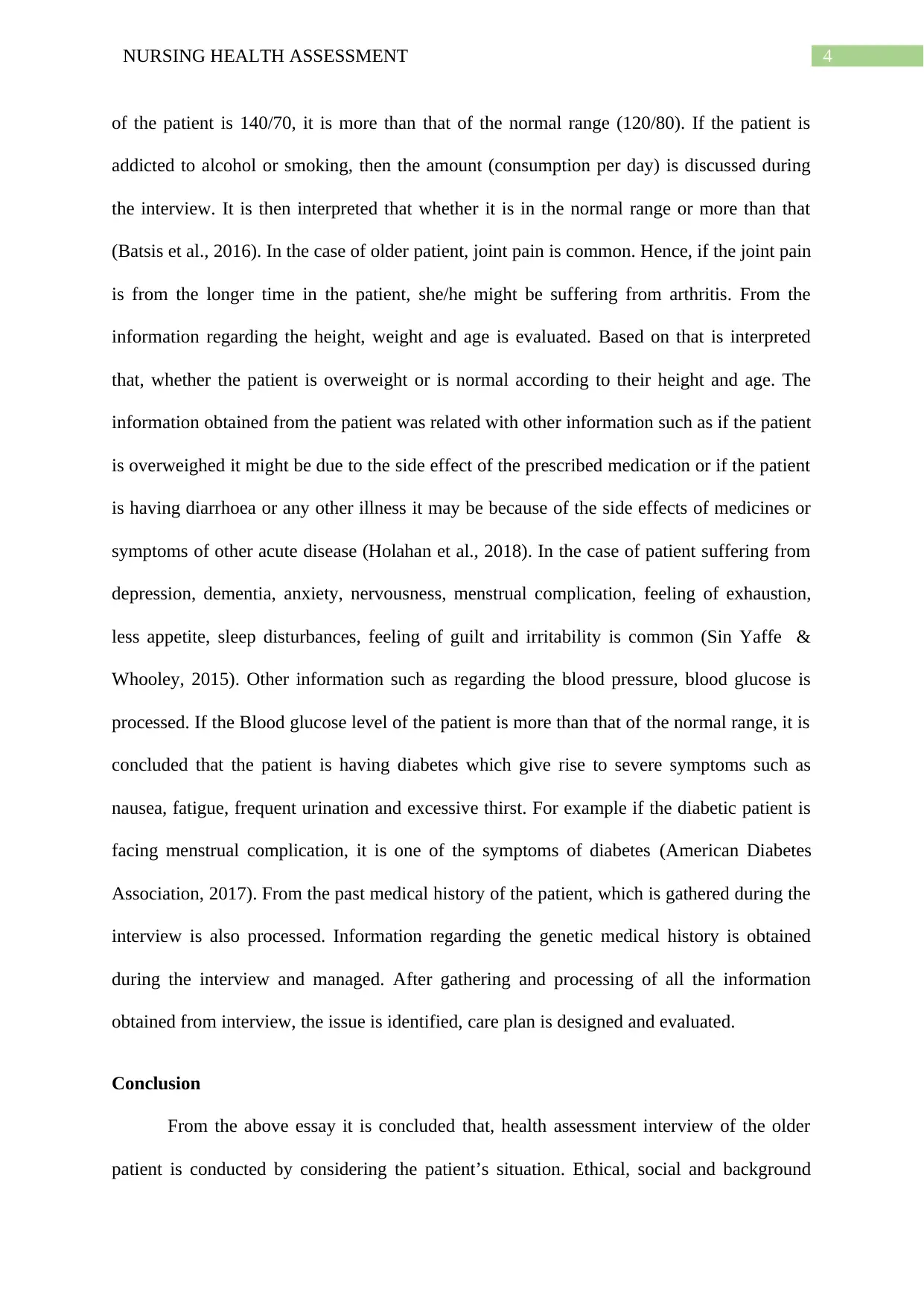
4NURSING HEALTH ASSESSMENT
of the patient is 140/70, it is more than that of the normal range (120/80). If the patient is
addicted to alcohol or smoking, then the amount (consumption per day) is discussed during
the interview. It is then interpreted that whether it is in the normal range or more than that
(Batsis et al., 2016). In the case of older patient, joint pain is common. Hence, if the joint pain
is from the longer time in the patient, she/he might be suffering from arthritis. From the
information regarding the height, weight and age is evaluated. Based on that is interpreted
that, whether the patient is overweight or is normal according to their height and age. The
information obtained from the patient was related with other information such as if the patient
is overweighed it might be due to the side effect of the prescribed medication or if the patient
is having diarrhoea or any other illness it may be because of the side effects of medicines or
symptoms of other acute disease (Holahan et al., 2018). In the case of patient suffering from
depression, dementia, anxiety, nervousness, menstrual complication, feeling of exhaustion,
less appetite, sleep disturbances, feeling of guilt and irritability is common (Sin Yaffe &
Whooley, 2015). Other information such as regarding the blood pressure, blood glucose is
processed. If the Blood glucose level of the patient is more than that of the normal range, it is
concluded that the patient is having diabetes which give rise to severe symptoms such as
nausea, fatigue, frequent urination and excessive thirst. For example if the diabetic patient is
facing menstrual complication, it is one of the symptoms of diabetes (American Diabetes
Association, 2017). From the past medical history of the patient, which is gathered during the
interview is also processed. Information regarding the genetic medical history is obtained
during the interview and managed. After gathering and processing of all the information
obtained from interview, the issue is identified, care plan is designed and evaluated.
Conclusion
From the above essay it is concluded that, health assessment interview of the older
patient is conducted by considering the patient’s situation. Ethical, social and background
of the patient is 140/70, it is more than that of the normal range (120/80). If the patient is
addicted to alcohol or smoking, then the amount (consumption per day) is discussed during
the interview. It is then interpreted that whether it is in the normal range or more than that
(Batsis et al., 2016). In the case of older patient, joint pain is common. Hence, if the joint pain
is from the longer time in the patient, she/he might be suffering from arthritis. From the
information regarding the height, weight and age is evaluated. Based on that is interpreted
that, whether the patient is overweight or is normal according to their height and age. The
information obtained from the patient was related with other information such as if the patient
is overweighed it might be due to the side effect of the prescribed medication or if the patient
is having diarrhoea or any other illness it may be because of the side effects of medicines or
symptoms of other acute disease (Holahan et al., 2018). In the case of patient suffering from
depression, dementia, anxiety, nervousness, menstrual complication, feeling of exhaustion,
less appetite, sleep disturbances, feeling of guilt and irritability is common (Sin Yaffe &
Whooley, 2015). Other information such as regarding the blood pressure, blood glucose is
processed. If the Blood glucose level of the patient is more than that of the normal range, it is
concluded that the patient is having diabetes which give rise to severe symptoms such as
nausea, fatigue, frequent urination and excessive thirst. For example if the diabetic patient is
facing menstrual complication, it is one of the symptoms of diabetes (American Diabetes
Association, 2017). From the past medical history of the patient, which is gathered during the
interview is also processed. Information regarding the genetic medical history is obtained
during the interview and managed. After gathering and processing of all the information
obtained from interview, the issue is identified, care plan is designed and evaluated.
Conclusion
From the above essay it is concluded that, health assessment interview of the older
patient is conducted by considering the patient’s situation. Ethical, social and background
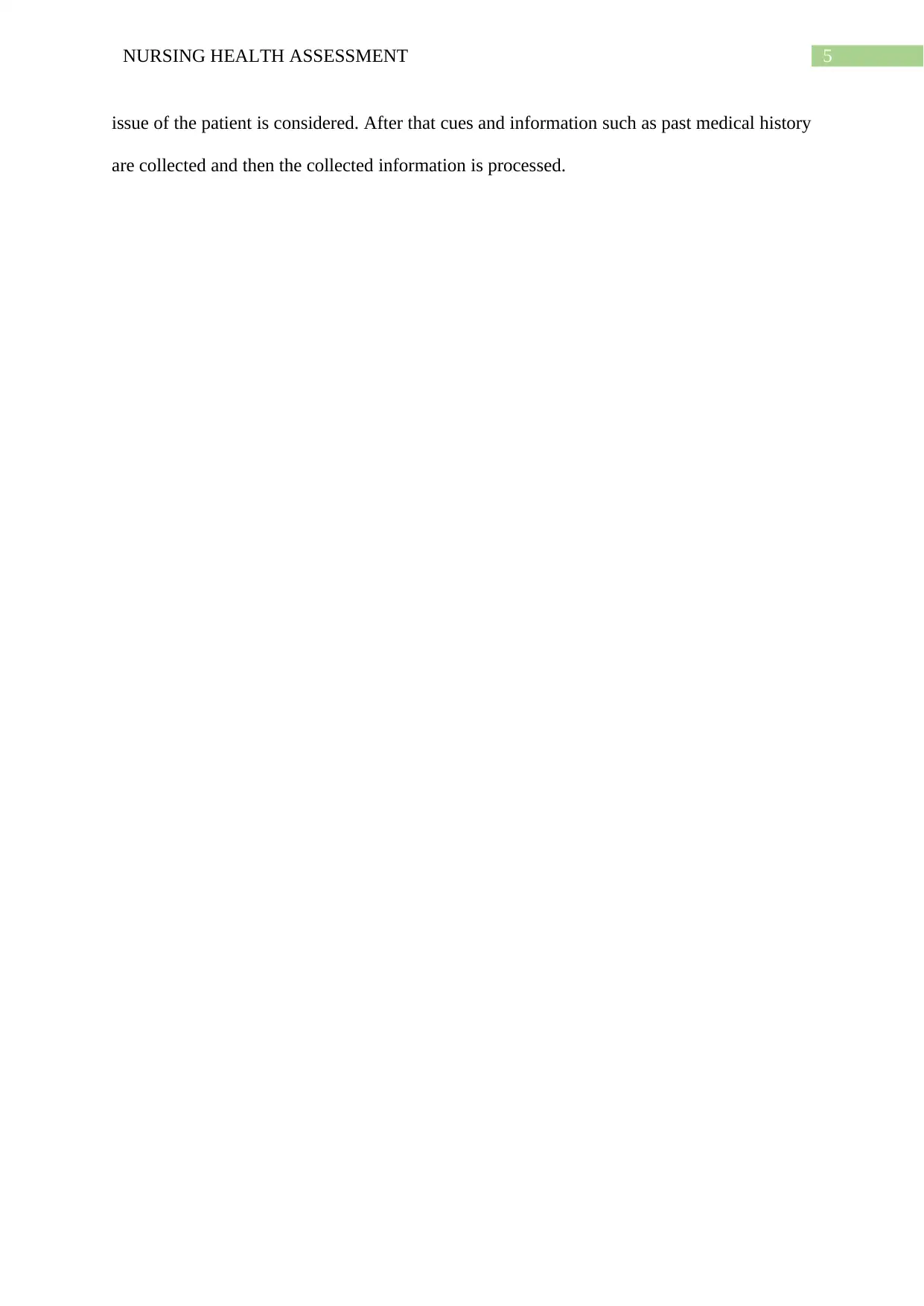
5NURSING HEALTH ASSESSMENT
issue of the patient is considered. After that cues and information such as past medical history
are collected and then the collected information is processed.
issue of the patient is considered. After that cues and information such as past medical history
are collected and then the collected information is processed.
⊘ This is a preview!⊘
Do you want full access?
Subscribe today to unlock all pages.

Trusted by 1+ million students worldwide
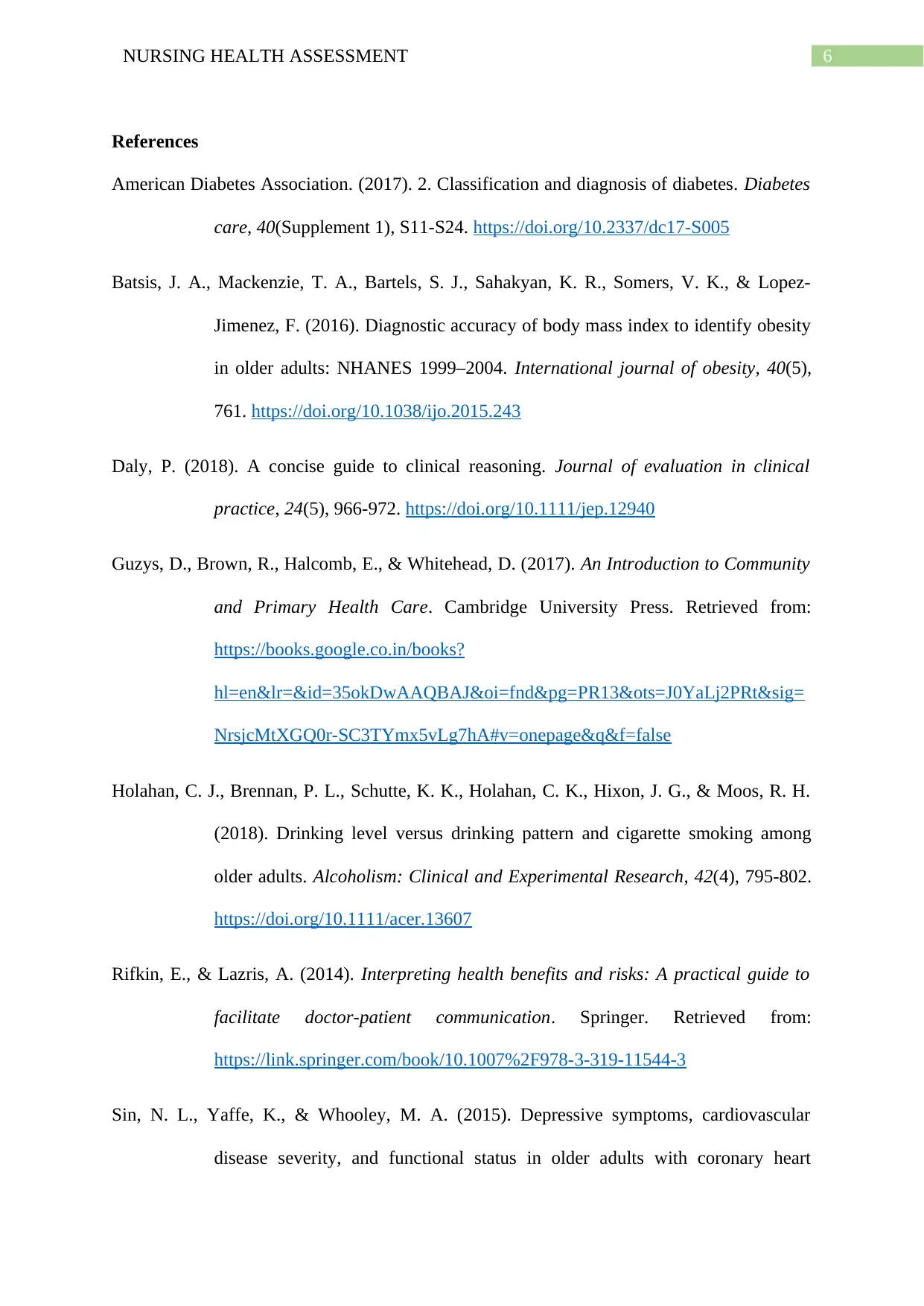
6NURSING HEALTH ASSESSMENT
References
American Diabetes Association. (2017). 2. Classification and diagnosis of diabetes. Diabetes
care, 40(Supplement 1), S11-S24. https://doi.org/10.2337/dc17-S005
Batsis, J. A., Mackenzie, T. A., Bartels, S. J., Sahakyan, K. R., Somers, V. K., & Lopez-
Jimenez, F. (2016). Diagnostic accuracy of body mass index to identify obesity
in older adults: NHANES 1999–2004. International journal of obesity, 40(5),
761. https://doi.org/10.1038/ijo.2015.243
Daly, P. (2018). A concise guide to clinical reasoning. Journal of evaluation in clinical
practice, 24(5), 966-972. https://doi.org/10.1111/jep.12940
Guzys, D., Brown, R., Halcomb, E., & Whitehead, D. (2017). An Introduction to Community
and Primary Health Care. Cambridge University Press. Retrieved from:
https://books.google.co.in/books?
hl=en&lr=&id=35okDwAAQBAJ&oi=fnd&pg=PR13&ots=J0YaLj2PRt&sig=
NrsjcMtXGQ0r-SC3TYmx5vLg7hA#v=onepage&q&f=false
Holahan, C. J., Brennan, P. L., Schutte, K. K., Holahan, C. K., Hixon, J. G., & Moos, R. H.
(2018). Drinking level versus drinking pattern and cigarette smoking among
older adults. Alcoholism: Clinical and Experimental Research, 42(4), 795-802.
https://doi.org/10.1111/acer.13607
Rifkin, E., & Lazris, A. (2014). Interpreting health benefits and risks: A practical guide to
facilitate doctor-patient communication. Springer. Retrieved from:
https://link.springer.com/book/10.1007%2F978-3-319-11544-3
Sin, N. L., Yaffe, K., & Whooley, M. A. (2015). Depressive symptoms, cardiovascular
disease severity, and functional status in older adults with coronary heart
References
American Diabetes Association. (2017). 2. Classification and diagnosis of diabetes. Diabetes
care, 40(Supplement 1), S11-S24. https://doi.org/10.2337/dc17-S005
Batsis, J. A., Mackenzie, T. A., Bartels, S. J., Sahakyan, K. R., Somers, V. K., & Lopez-
Jimenez, F. (2016). Diagnostic accuracy of body mass index to identify obesity
in older adults: NHANES 1999–2004. International journal of obesity, 40(5),
761. https://doi.org/10.1038/ijo.2015.243
Daly, P. (2018). A concise guide to clinical reasoning. Journal of evaluation in clinical
practice, 24(5), 966-972. https://doi.org/10.1111/jep.12940
Guzys, D., Brown, R., Halcomb, E., & Whitehead, D. (2017). An Introduction to Community
and Primary Health Care. Cambridge University Press. Retrieved from:
https://books.google.co.in/books?
hl=en&lr=&id=35okDwAAQBAJ&oi=fnd&pg=PR13&ots=J0YaLj2PRt&sig=
NrsjcMtXGQ0r-SC3TYmx5vLg7hA#v=onepage&q&f=false
Holahan, C. J., Brennan, P. L., Schutte, K. K., Holahan, C. K., Hixon, J. G., & Moos, R. H.
(2018). Drinking level versus drinking pattern and cigarette smoking among
older adults. Alcoholism: Clinical and Experimental Research, 42(4), 795-802.
https://doi.org/10.1111/acer.13607
Rifkin, E., & Lazris, A. (2014). Interpreting health benefits and risks: A practical guide to
facilitate doctor-patient communication. Springer. Retrieved from:
https://link.springer.com/book/10.1007%2F978-3-319-11544-3
Sin, N. L., Yaffe, K., & Whooley, M. A. (2015). Depressive symptoms, cardiovascular
disease severity, and functional status in older adults with coronary heart
Paraphrase This Document
Need a fresh take? Get an instant paraphrase of this document with our AI Paraphraser
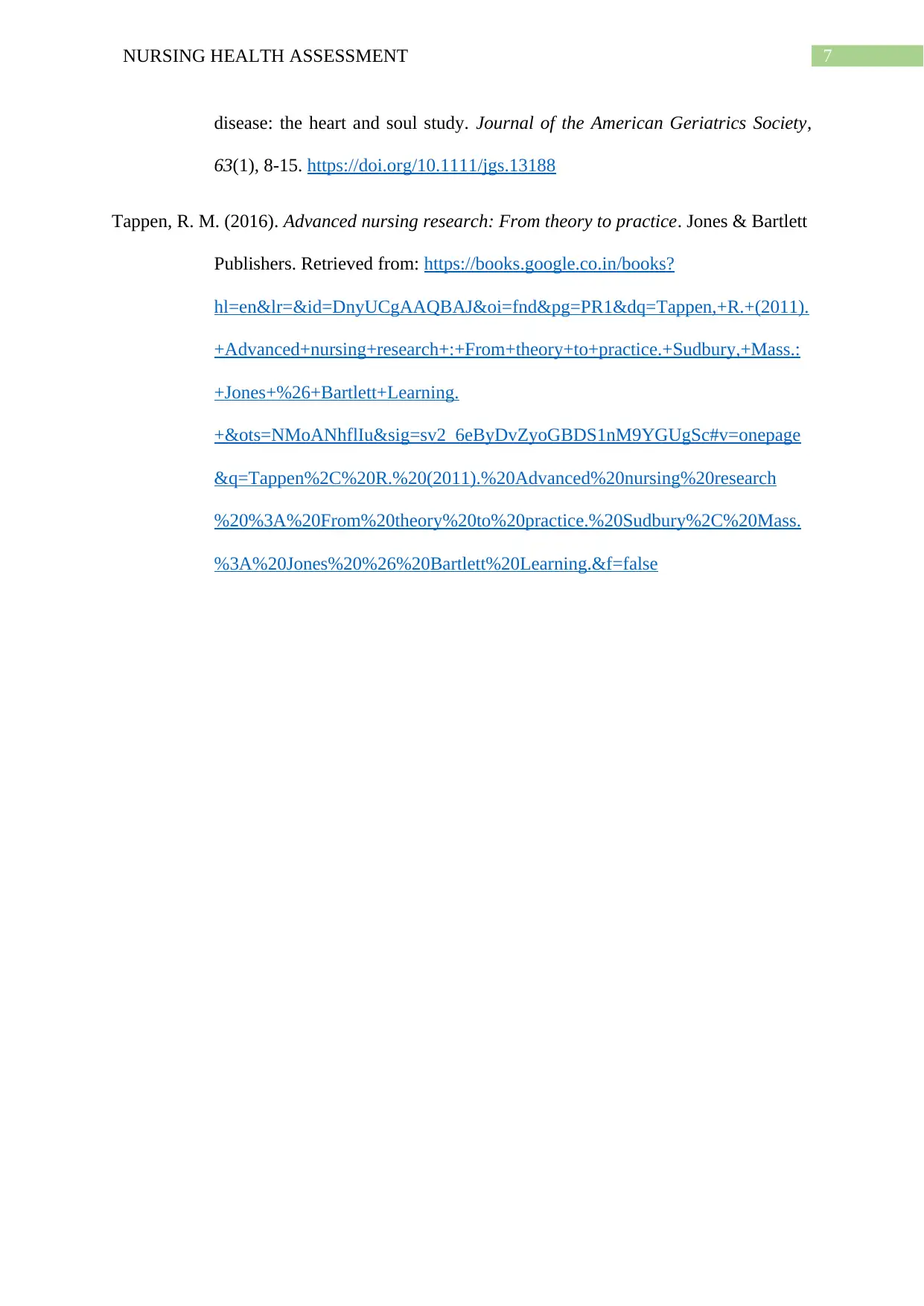
7NURSING HEALTH ASSESSMENT
disease: the heart and soul study. Journal of the American Geriatrics Society,
63(1), 8-15. https://doi.org/10.1111/jgs.13188
Tappen, R. M. (2016). Advanced nursing research: From theory to practice. Jones & Bartlett
Publishers. Retrieved from: https://books.google.co.in/books?
hl=en&lr=&id=DnyUCgAAQBAJ&oi=fnd&pg=PR1&dq=Tappen,+R.+(2011).
+Advanced+nursing+research+:+From+theory+to+practice.+Sudbury,+Mass.:
+Jones+%26+Bartlett+Learning.
+&ots=NMoANhflIu&sig=sv2_6eByDvZyoGBDS1nM9YGUgSc#v=onepage
&q=Tappen%2C%20R.%20(2011).%20Advanced%20nursing%20research
%20%3A%20From%20theory%20to%20practice.%20Sudbury%2C%20Mass.
%3A%20Jones%20%26%20Bartlett%20Learning.&f=false
disease: the heart and soul study. Journal of the American Geriatrics Society,
63(1), 8-15. https://doi.org/10.1111/jgs.13188
Tappen, R. M. (2016). Advanced nursing research: From theory to practice. Jones & Bartlett
Publishers. Retrieved from: https://books.google.co.in/books?
hl=en&lr=&id=DnyUCgAAQBAJ&oi=fnd&pg=PR1&dq=Tappen,+R.+(2011).
+Advanced+nursing+research+:+From+theory+to+practice.+Sudbury,+Mass.:
+Jones+%26+Bartlett+Learning.
+&ots=NMoANhflIu&sig=sv2_6eByDvZyoGBDS1nM9YGUgSc#v=onepage
&q=Tappen%2C%20R.%20(2011).%20Advanced%20nursing%20research
%20%3A%20From%20theory%20to%20practice.%20Sudbury%2C%20Mass.
%3A%20Jones%20%26%20Bartlett%20Learning.&f=false
1 out of 8
Related Documents
Your All-in-One AI-Powered Toolkit for Academic Success.
+13062052269
info@desklib.com
Available 24*7 on WhatsApp / Email
![[object Object]](/_next/static/media/star-bottom.7253800d.svg)
Unlock your academic potential
Copyright © 2020–2025 A2Z Services. All Rights Reserved. Developed and managed by ZUCOL.





